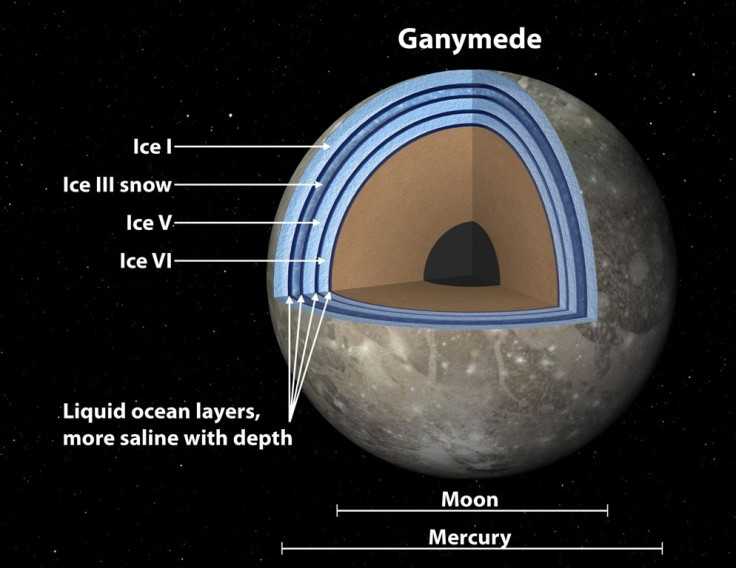Jupiter’s Moon Ganymede, Largest Of Its Kind In Solar System, May Harbor 'Club Sandwich' Of Oceans And Ice

Jupiter’s moon Ganymede might have ice and oceans stacked up in several layers like a club sandwich, according to a new NASA-funded study, which disagrees with a previous theory suggesting that the moon had a thick ocean between only two layers of ice.
According to scientists, the results of the new study support the idea that ancient life might have possibly existed on the icy moon as places where water and rock interact are important for the development of life.
“Ganymede’s ocean might be organized like a Dagwood sandwich,” Steve Vance of NASA's Jet Propulsion Laboratory (JPL) in Pasadena, California, said earlier this week in a statement. “Its ocean is huge, with enormous pressures, so it was thought that dense ice had to form at the bottom of the ocean. When we added salts to our models, we came up with liquids dense enough to sink to the sea floor.”
NASA scientists first suspected an ocean in Ganymede, the largest moon in the solar system, in the 1970s. In the 1990s, NASA's Galileo mission confirmed Ganymede’s ocean, showing it extends to depths of hundreds of miles. The spacecraft also found evidence for salty seas, likely containing the salt magnesium sulfate, NASA said.
Vance and his team of researchers performed laboratory experiments to show how much salt really increases the density of liquids under the extreme conditions inside Ganymede and similar moons.
According to scientists, the ice that floats in our drinks is called “Ice I” and it's the least dense form of ice and lighter than water. But at high pressures, like those in the deep oceans like Ganymede’s, the ice crystal structures become more compact. The ice can become so dense that it is heavier than water and falls to the bottom of the sea.
By modeling these processes using computers, the scientists came up with an ocean sandwiched between as many as three ice layers, in addition to the rocky seafloor. The lightest ice is on top, and the saltiest liquid sinks to the bottom because of its weight.
“We don’t know how long the Dagwood-sandwich structure would exist,” Christophe Sotin of JPL said in a statement. “This structure represents a stable state, but various factors could mean the moon doesn't reach this stable state.”
Ganymede is one of five moons in the solar system that are believed to support vast oceans beneath icy crusts. The other moons are Jupiter's Europa and Callisto and Saturn's Titan and Enceladus.
© Copyright IBTimes 2024. All rights reserved.






















